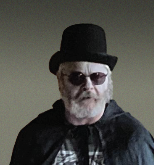They’ve Invented A Device That Lets You See Through Walls.
Sometimes you look at a window and you see straight through it.
Sometimes you look at a window and you see yourself, looking back.
Sometimes you look at a window and you see nothing at all.
And sometimes the window lights up and starts to move.
It’s wrong to go looking in other peoples’ windows.
No matter how curious, how drawn by the glimpses afforded into other people’ lives, to peek through the glass, past the reflections, into the living rooms and kitchens of other peoples’ homes is a kind of mild-to-strong social taboo. Nobody’s going to hunt you down and put you in jail, unless you’re transgressing in particularly disturbing ways, but it will draw frowns, head-shakes, disapproval, and at a minimum disturb the occupants, if there happen to be any enacting their own private dramas while you treat their window as a television or computer screen providing you with entertainment and distraction.
Windows, literal and metaphorical, are breaks in the walls we put up to keep the world out and ourselves, our families, our things, in. They are vulnerable spots in our defences, because of course, we need light, we need air, we need the view of the outside, since to hermetically seal yourself away is unbearable.
We look out, the world looks back in. Sunshine falls against the panes, moonlight slants through them, frost coats them, spiders spin webs, insects bounce or crawl across them, little eco-systems that survive until the next spring clean. They are tokens of trust in the social order and the consideration of others. They are easily broken, both the glass and the trust, and yet we build no homes without them.
I once threw a rock through a window. It was an accident, I swear.
I didn’t see it break, but I heard it, and in that sound my young world seemed to come to an end. It was the herald of an apocalypse of furious punishing adults. I remained, paralysed, where I was, playing in a pile of sand from which we had been throwing stones over the wall into the neighbour’s garden for no reason other than to throw things over a wall. We didn’t want to make a mess. I didn’t want to break a window.
Nothing could touch me. I had done the worst thing in my life and all that was left were the consequences, which I deserved.
Imagine, sitting in a room, enjoying your supper on a peaceful summer evening, or watching the news in your living room, when suddenly a rock explodes though the glass, sending shards flying and tumbling down onto the carpet or over the sofa while you jump in sudden terror and stare in disbelief at what has just occurred.
In the end I wasn’t even yelled at, just sent to my room. I think they saw the shock of what I’d done in my face and in my eyes, as if something had been broken inside.
There: that was me letting you look through a window into my life, my memories. Windows, after all, come in all shapes and sizes, and can be found in the most unexpected of places. And every now and then, the window throws something at you.
In November, in the winter, as the cold clamps down on the streets and we hurry to our destinations through wind and rain and frost, some windows light up, as if by magic, and invite you to stop for a moment, and look inside. Projected on each window are images specially designed and created to let you look in, and out, and across, and perhaps back into yourself.
Let your eyes rest on those windows, and in doing so break no trust.
Stand and stare.
Indulge that fascination and curiosity.
You are being given a gift. You are being entrusted with these visions from other worlds, other lives, other memories.
Even if you hurry past and do not stop, you will glimpse them from the corner of your eye, the way you sometimes glimpse rooms and people, and sometimes those glimpses linger, and haunt you through the long cold of the season, and when the windows themselves grow dark, in your mind at least one might once again light up, and you will pause and stand and look through the window, fascinated, enchanted, transported, into somewhere else.

Nigel Quinlan has written two books for children, The Maloneys’ Magical Weatherbox and The Cloak Of Feathers, both published by Hachette. His stories have appeared in The Caterpillar, The Book Smugglers’ Quarterly Almanac and Ember Journal. In 2019 he was wrietr in resdience at Nenagh Arts Centre and was commissioned the Centre to work with schoolchildren to produce a book of stories inspired by Celtic Mythical Creatures, illustrated by Carine Arnakis. In 2022 he again worked with Nenagh Arts Centre and local schoolchildren, and with pupeteer Caoimhe Dunn, to devise a script for a shadow puppet show, Oisin And The Dragon’s Curse. His poem, My Best Friend’s A Monster, is included in the new anthology of childrens’ poetry from Little Island, I Am The Wind. He lives in Cloughjordan Co Tipperary with his family and their dog.
